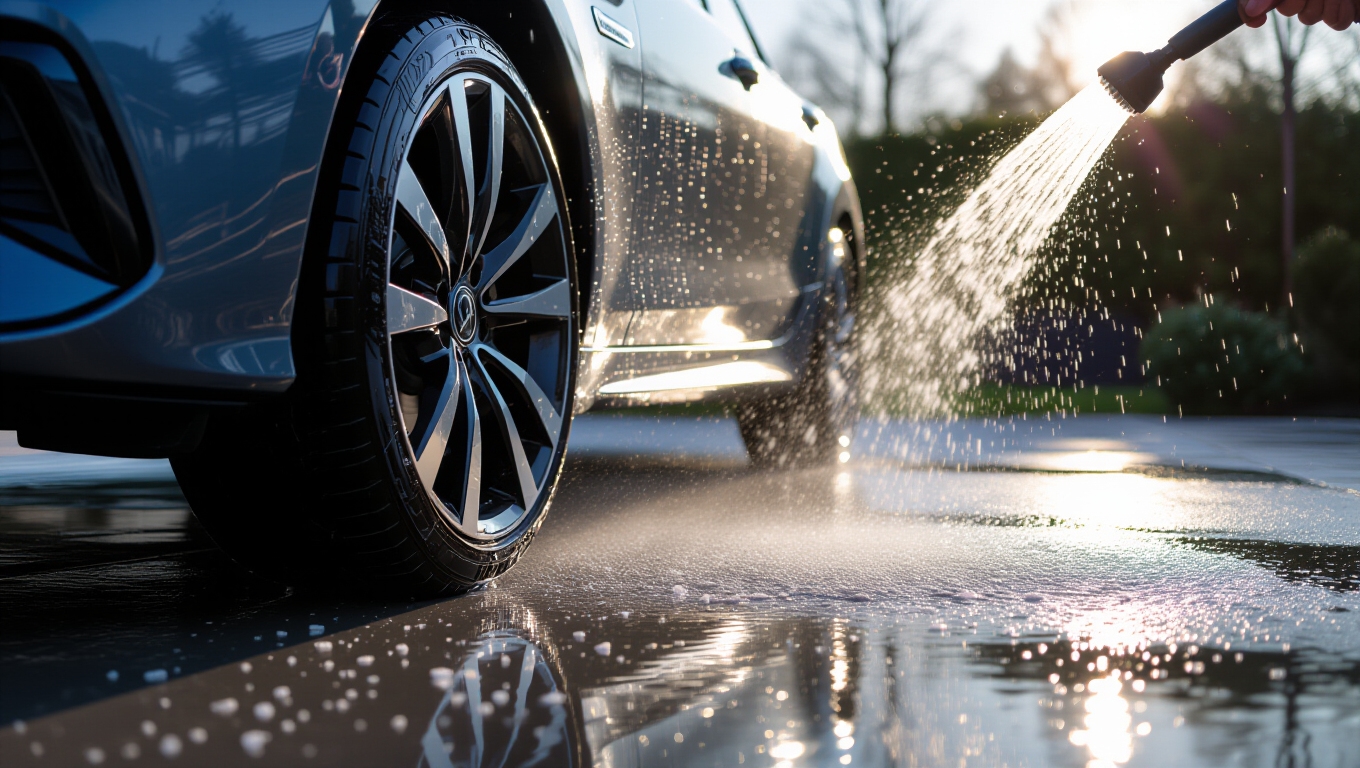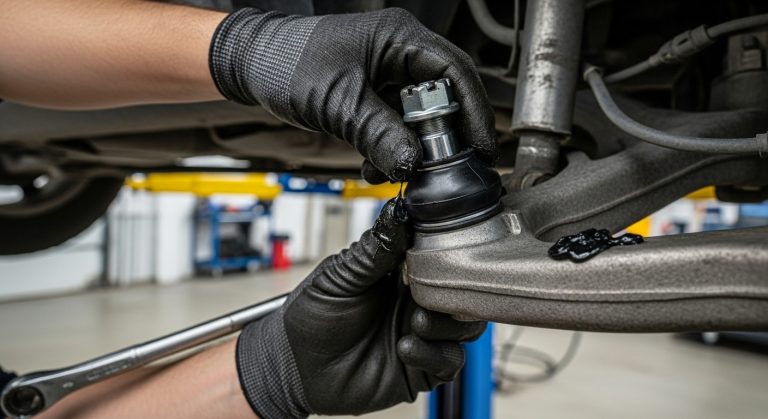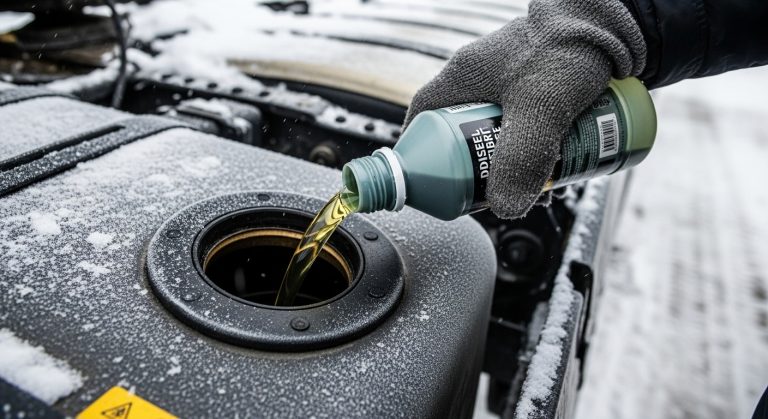To effectively remove salt from your car, rinse the entire vehicle, especially the undercarriage and wheel wells, with warm water using a pressure washer at a moderate angle to loosen and wash away salt deposits.
Apply acid-based prewashes or specialized de-icers on cool surfaces for tough buildup, then rinse thoroughly.
Use mechanical brushes for deep cleaning, and repeat washes every 10 days during heavy salt exposure.
Protective coatings and rust inhibitors boost corrosion resistance.
Understanding these steps guarantees thorough salt removal and better protection.
Key Takeaways
- Rinse the car thoroughly with high-pressure water, starting from the top down, focusing on undercarriage and wheel wells to remove salt deposits.
- Use warm water during washing to dissolve and loosen salt, grime, and oils more effectively without damaging paint.
- Apply acid-based prewash sprays containing mild acids like citric acid on cool surfaces to chemically break down salt crystals before rinsing.
- Regularly apply protective wax or ceramic coatings and undercoating treatments to create barriers against salt corrosion.
- Schedule washes every 10 days during heavy salt exposure and after snowfalls to prevent buildup and minimize corrosion risks.
Immediate Rinsing Techniques for Salt Removal
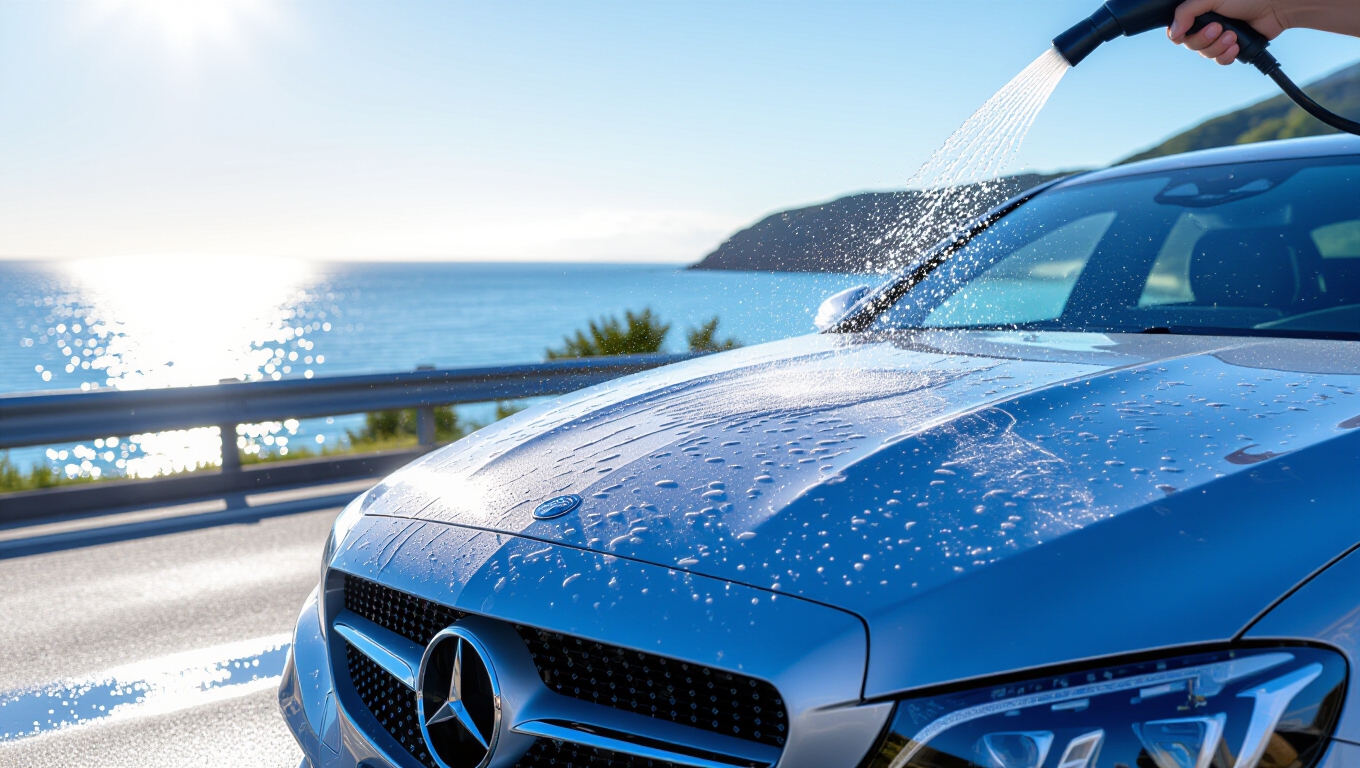
Although it might seem straightforward, immediate rinsing with high-pressure water is essential to prevent salt-induced corrosion and paint damage on your car. Use a pressure washer or high-pressure hose to thoroughly rinse salt from the undercarriage, wheel wells, and suspension—areas prone to accumulation.
This step is crucial because salt accelerates rusting of metal components like the frame, brake lines, and exhaust system. Additionally, neglecting to remove salt can contribute to heater core blockages due to corrosion and debris buildup in vehicle systems.
Start rinsing from the top, moving downward to ensure all surfaces, including glass, paint, and trim, are salt-free. Avoid excessive jet pressure to protect delicate components.
Regular rinsing every 10 days, or more during heavy salt exposure, minimizes buildup. If water supply is limited, pre-fill buckets with warm water for incremental rinsing.
Warm water improves salt dissolution but avoid temperature shocks to paint. This methodical approach guarantees salt doesn’t linger, effectively reducing corrosion risk and preserving your vehicle’s finish.
Effective Prewash and Chemical Treatments
Start by rinsing your car with warm water to loosen salt deposits and improve chemical effectiveness. This step helps prevent rubbing salt into the paint, which can cause damage over time.
Applying a prewash solution with properties similar to how filtration efficiency balances protection and performance can optimize cleaning without harming surfaces. Apply an acid-based prewash, carefully diluted, to chemically break down residual salt without damaging surfaces.
Using acid pre-wash restores the hydrophobic properties of ceramic coatings that may have degraded. Incorporate an iron remover to target embedded contaminants, ensuring thorough salt elimination before the main wash.
Warm Water Rinse
When you rinse your car with warm water at around 100°F (38°C), you effectively dissolve and loosen road salt, grime, and oils that cold water alone can’t remove as efficiently. This temperature optimizes salt dissolution, preventing abrasive residues from damaging your paint.
Warm water also minimizes scrubbing effort and reduces paint scratch risk while avoiding thermal shock common with hot water.
To maximize results:
- Thoroughly spray all areas, including wheel wells and undercarriage, to loosen salt accumulations.
- Use warm water before applying soaps or chemical treatments to soften deposits.
- Rinse again with warm water post-cleaning to remove soap and chemical residues.
Frequent warm water rinses, ideally biweekly during salt exposure, prevent corrosive buildup and maintain vehicle integrity. Using cleaning methods with proven filtration efficiency helps protect your vehicle’s engine from salt-related damage.
Acid-Based Prewash
Because road salt creates stubborn inorganic deposits on your vehicle, using an acid-based prewash is essential to effectively neutralize and break down these contaminants before the main wash.
These prewash products typically contain mild acids like citric acid that lower pH, dissolving salt crystals, minerals, and lime deposits. Salt removers also often include corrosion inhibitors to provide added protection to metal surfaces during cleaning.
Surfactants then lift loosened grime for easy rinsing. Apply the acid prewash as a spray or foam on cool, shaded surfaces to prevent paint damage, allowing brief dwell time without drying.
Afterward, rinse thoroughly to remove residues and avoid prolonged acid exposure. This step is crucial because improper cleaning can accelerate rust formation, especially when residual engine protection oils like synthetic lubricants are compromised.
This method not only removes hard water spots and salt stains more effectively than water alone but also preserves ceramic coatings and reduces corrosion risks by fully neutralizing residual salt on metal parts.
Always follow safety guidelines and test on inconspicuous areas first.
Iron Remover Use
Although iron removers are essential for eliminating embedded iron particles from your car’s paint and wheels, applying them properly guarantees maximum effectiveness and surface safety. To optimize use:
- Apply multiple light sprays, keeping the surface wet to convert iron particles; avoid letting it dry to prevent white residue. Using a clean, pre-washed surface ensures iron remover works effectively without competing with dirt, enhancing overall chemical effectiveness.
- Agitate gently with a microfiber towel after a short dwell time to increase iron removal up to tenfold. This method is similar to how additive formulations enhance gear oil performance by improving protective film strength.
- Rinse thoroughly before drying to prevent residue buildup, and repeat treatment every 3–4 months to avoid corrosion risks.
Iron removers use chelating agents that safely dissolve iron contamination, indicated by color changes (purple/red). Overuse or improper rinsing can accelerate rust, especially on bare metal.
Follow these steps precisely to neutralize iron fallout effectively while preserving paint and metal integrity.
Choosing the Right Washing Products for Salt
Selecting the right washing products for salt removal hinges on understanding their chemical composition and functional roles. You’ll want products containing acidic neutralizers like citric acid to break down salt crystals, surfactants to lift residues, and corrosion inhibitors to protect metal surfaces.
It is important to remember that road salt is abrasive and requires specialized removal techniques to prevent damage. Additives can enhance your existing soap’s effectiveness without harming paint.
Avoid relying solely on water or homemade solutions, as they lack the chemical action necessary for thorough cleaning. For vehicles exposed to harsh winter conditions, using products with engine protection additives can further safeguard exposed metal parts from corrosion.
| Product Feature | Function | Emotional Benefit |
|---|---|---|
| Acidic Neutralizers | Dissolve bonded salt crystals | Confidence in deep cleaning |
| Surfactants | Emulsify and lift residues | Satisfaction of spotless finish |
| Corrosion Inhibitors | Protect metal from rust | Peace of mind over damage |
| Additives | Boost cleaning efficiency | Convenience and effectiveness |
| Paint-safe Formulas | Prevent paint degradation | Assurance of vehicle care |
Best Practices for Undercarriage Cleaning
You need to rinse your undercarriage thoroughly with high-pressure water to remove salt buildup effectively. Salt is highly corrosive and can cause metal erosion and rust if not removed promptly.
Use specialized tools like pressure washers and brushes designed for tight spaces to clean hard-to-reach areas. Regularly washing the undercarriage after salt exposure is critical to prevent corrosion and extend your vehicle’s lifespan.
Additionally, maintaining brake fluid quality is important since salt and moisture can impact braking system components and overall vehicle safety.
Importance of Undercarriage Rinse
When road salt accumulates on your vehicle’s undercarriage, it accelerates rust and corrosion that can compromise structural integrity and mechanical components. Regular undercarriage rinsing is essential to remove corrosive salt deposits and prevent metal weakening.
It also helps maintain the structural integrity of the undercarriage by preventing rust-related damage, which is crucial for the vehicle’s longevity. Using protective measures such as corrosion prevention can further enhance the effectiveness of your cleaning routine.
Neglecting this can lead to brake line failures, exhaust damage, and frame deterioration. You should prioritize rinsing because:
- It safeguards critical safety systems like brakes and suspension from salt-induced malfunctions.
- It maintains mechanical performance, reducing drag and preserving fuel efficiency by eliminating grime buildup.
- It extends your vehicle’s lifespan by preventing costly repairs linked to corrosion and environmental pollutants. Additionally, this practice supports prolonged lifespan by reducing the need for frequent repairs and replacements over time.
Tools for Undercarriage Cleaning
Although undercarriage cleaning can be challenging due to hard-to-reach areas, using the right tools makes the process efficient and thorough. Start with a pressure washer or hose equipped with a high-pressure nozzle to dislodge salt and grime effectively. Regular cleaning is especially important during winter months to prevent rust and corrosion caused by road salt.
Employ specialized undercarriage cleaner attachments—like Adam’s Wand or Karcher models—with multiple nozzles angled precisely at 65 degrees to cover wide areas uniformly. Use heavy-duty degreasers such as Chemical Guys Heavy Duty Degreaser to break down salt deposits without damaging vehicle materials. Choosing cleaning tools that can handle extreme temperatures ensures effectiveness throughout the winter season.
Complement with foamers for even chemical application and detailing brushes to scrub stubborn buildup in tight spaces. Accessories like pump sprayers and swivel extensions improve reach and control, ensuring exhaustive cleaning of all undercarriage components.
These tools work systematically to prevent corrosion and prolong vehicle integrity.
Frequency of Undercarriage Wash
Because road salt accelerates corrosion, washing your vehicle’s undercarriage every 2 to 3 weeks during winter is crucial. This practice removes salt and moisture that cause rust and damage to essential components like brake lines and suspension.
Many automated car wash systems include specialized undercarriage sprays that efficiently target these hard-to-reach areas, making regular cleaning more convenient and effective. Regular inspections of your vehicle’s undercarriage for damage or buildup can help identify issues before they worsen.
Adjust frequency depending on conditions:
- Off-road or mud exposure requires immediate cleaning after each use to prevent debris buildup.
- Urban or daily commuting vehicles benefit from monthly washes to combat grime and pollutants.
- In dry, paved areas with minimal contaminants, washing every 3 to 6 months suffices.
Maintaining this schedule preserves your vehicle’s underbody integrity and extends its lifespan. Additionally, applying rust inhibitors post-wash enhances protection and mimics the use of sealant for corrosion prevention commonly applied in RV vent maintenance.
Tailor your cleaning routine to environmental factors and driving patterns to optimize corrosion prevention and ensure long-term vehicle reliability.
Interior Salt Removal Strategies
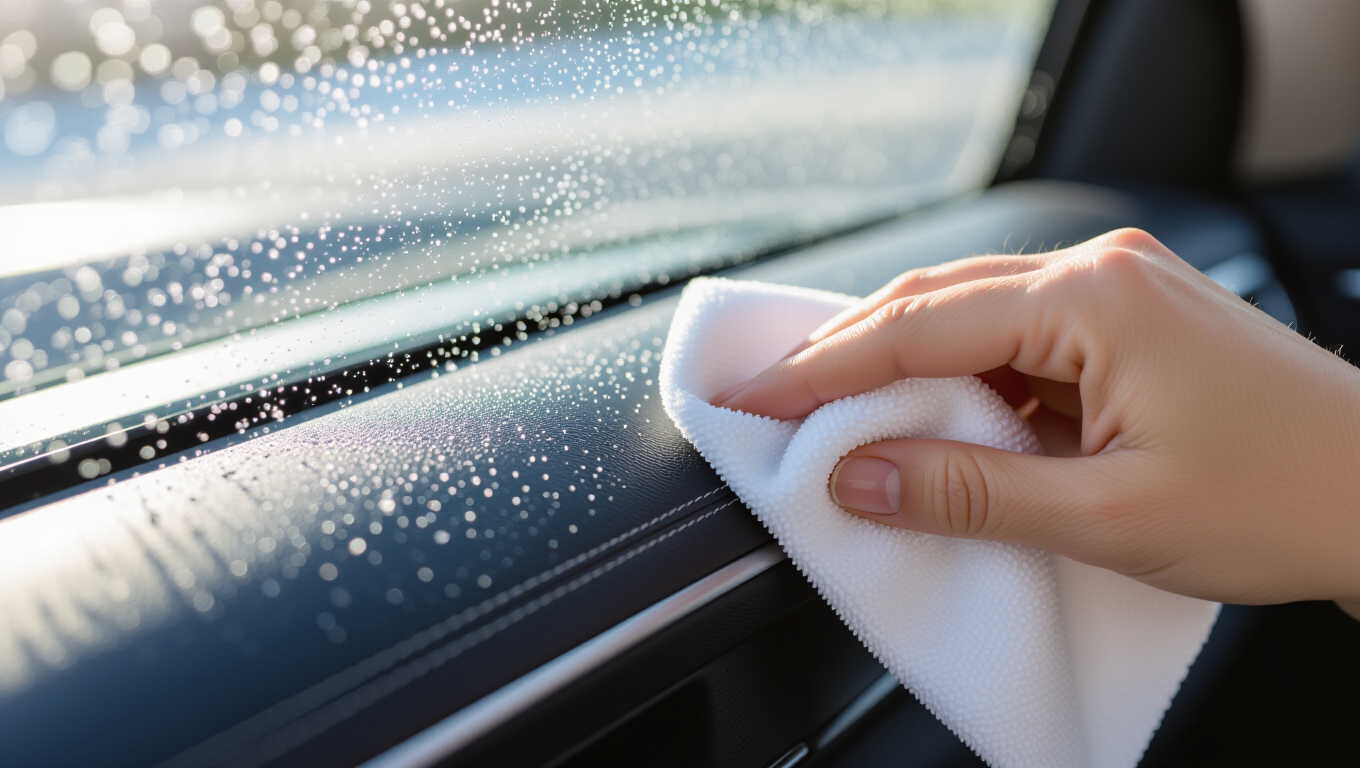
Since salt can embed deeply into your vehicle’s interior fabrics, you need to start by thoroughly vacuuming carpets and upholstery to remove loose particles and debris. Use a handheld vacuum or hose attachment to reach under carpets and beneath floor mats, focusing on high-traffic areas where salt accumulates most. This step is crucial because residue can be abrasive, leading to carpet fiber deterioration.
After vacuuming, apply a mild cleaning solution—mix warm water with a few drops of dish soap or use a commercial carpet cleaner—and test it on a hidden spot first. Lightly blot salt stains from edges to center without saturating fibers, then rinse with a damp cloth.
For stubborn residues, consider specialized salt stain removers designed to dissolve embedded salt crystals.
Finally, ensure interiors dry completely to prevent mold growth by ventilating or using fans if necessary.
Utilizing Mechanical Tools for Deep Cleaning
When tackling salt buildup on your vehicle, utilizing mechanical tools enhances cleaning efficiency by physically loosening and removing embedded salt crystals. Start with a high-pressure rinse, spraying from top to bottom to dislodge salt without damaging paint. It is important to clean the undercarriage every 10 days during winter to prevent salt-related damage and corrosion.
Next, use soft wash mitts or automotive brushes with soapy water to scrub surfaces gently, focusing on wheels and wheel wells where salt accumulates heavily.
Finally, employ undercarriage cleaning tools—specialized nozzles or mechanized washers—to reach salt deposits beneath the car.
- Use high-pressure water to rinse salt from hard-to-reach areas carefully.
- Scrub exterior surfaces with soft, automotive-specific brushes to avoid paint damage.
- Clean the undercarriage mechanically to remove persistent salt buildup effectively.
These steps ensure thorough salt removal while preserving your vehicle’s finish and structure.
Optimal Washing Frequency and Timing
Although salt exposure varies, you should wash your vehicle every 7 to 14 days during winter to limit corrosion effectively. Increase the frequency to every 7 to 10 days if you drive daily on salted roads or park outdoors.
Schedule washes on days when temperatures exceed 0°C (32°F) to prevent water freezing in crevices. Avoid washing immediately after heavy snowfall or during extremes of cold when salt application is ongoing.
Plan washes when temperatures rise above freezing and avoid immediately after snowfalls or during heavy salt use.
Focus on thorough rinsing, especially undercarriage and wheel wells, where salt accumulates most. Using a car wash with an undercarriage spray can help target these salt-prone areas effectively.
Early spring washes are essential to remove residual salt before it initiates corrosion.
Adjust your washing intervals based on visible salt buildup and environmental exposure. This methodical approach minimizes rust risks while maintaining your vehicle’s structural integrity throughout winter months.
Protective Measures Against Salt Damage
To effectively protect your vehicle from salt damage, you need to apply specialized coatings and utilize physical barriers that prevent salt contact with vulnerable surfaces. Start by applying high-quality waxes or ceramic coatings to create a chemical-resistant shield that repels salt and simplifies cleaning.
Next, professional undercoating treatments protect the undercarriage, especially frame rails and brake lines, from corrosive salt spray. These areas are particularly susceptible to accelerated oxidation due to salt exposure. Additionally, physical barriers like mud flaps and splash guards reduce salt accumulation on lower panels and wheel wells.
- Apply durable protective coatings regularly throughout winter.
- Install mud flaps and splash guards to limit salt spray exposure.
- Use rust inhibitors promptly on exposed metal to slow corrosion.
These methodical steps considerably reduce salt-induced corrosion and extend your vehicle’s lifespan.
Frequently Asked Questions
Can Salt Damage a Car’s Electrical Components?
Yes, salt can damage your car’s electrical components by accelerating corrosion on metal parts like wiring, connectors, and battery terminals. When salt combines with moisture and oxygen, it causes oxidation that deteriorates these components, leading to electrical failures such as malfunctioning lights or ignition issues.
You should regularly inspect and clean these parts, especially in areas prone to salt exposure, to maintain electrical integrity and prevent costly damage.
Is It Safe to Use Household Vinegar on Car Paint?
Wondering if household vinegar is safe for your car’s paint? You should know vinegar’s acidity can strip wax and dull paint, especially if undiluted or left on hot surfaces.
Always dilute it 50/50 with water, apply only on cool paint, and rinse thoroughly afterward.
Avoid using it on freshly waxed surfaces or delicate finishes like ceramic coatings.
Use vinegar cautiously, as improper use risks permanent damage to your car’s paint integrity.
How Long Does Salt Typically Take to Cause Rust?
Salt can cause rust to form on your car’s metal surfaces within a few weeks to a couple of months, especially if paint is chipped or scratched.
Corrosion accelerates with repeated exposure, moisture, and temperature fluctuations. Undercarriage rust can become visible during the first winter season of salt exposure.
To minimize damage, promptly remove salt residue and maintain protective coatings, as salt acts as an electrolyte speeding up oxidation and rust initiation.
Are Salt-Removal Products Environmentally Friendly?
Imagine your car as a delicate garden, vulnerable to the harsh winter salt storm. You’ll find many salt-removal products now use biodegradable, non-toxic formulas that break down naturally, protecting local plants and water.
These eco-friendly solutions minimize chemical pollution, reduce water use, and often come in recyclable packaging. By choosing such products, you methodically prevent environmental harm while effectively cleansing your vehicle from corrosive salt residues.
Can Salt Buildup Affect Tire Performance or Safety?
Yes, salt buildup directly affects tire performance and safety. It dehydrates and cracks rubber, causing brittleness and structural damage.
Salt also corrodes internal steel belts, weakening tires and increasing blowout risks. Additionally, it lowers tire pressure in cold conditions, reducing traction and causing uneven tread wear.
You must monitor pressure, inspect tires regularly, and remove salt to maintain ideal tire integrity and guarantee safe driving conditions.
Make Salt Removal a Habit – Your Car Will Thank You
If you prefer your car to resemble a salt sculpture rather than a sleek machine, by all means, ignore rinsing and protective measures.
But if you want to avoid turning your undercarriage into a rust factory, you’ll rinse immediately, prewash with the right chemicals, and scrub thoroughly.
Follow precise washing schedules and use proper tools—because salt isn’t just seasoning, it’s a relentless metal assassin.
Your car’s longevity depends on your methodical, no-nonsense salt removal routine.

